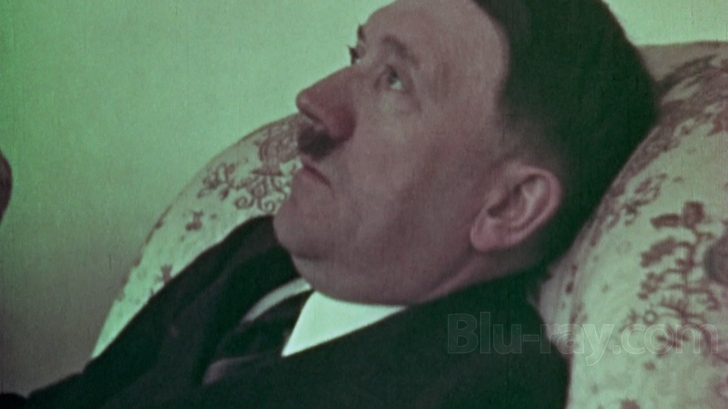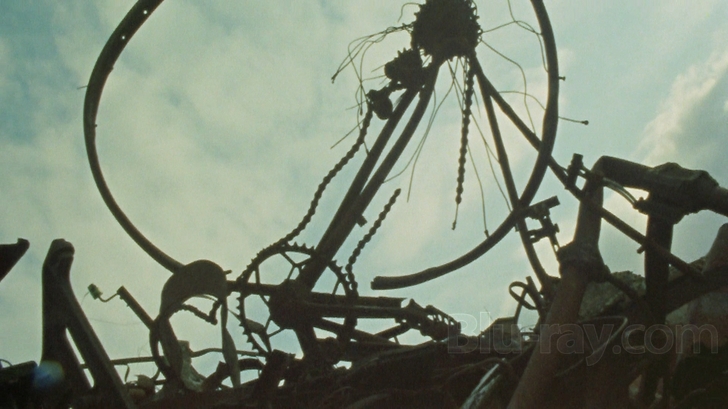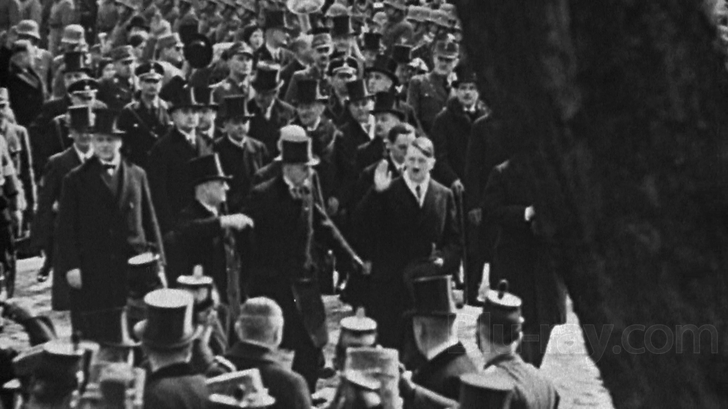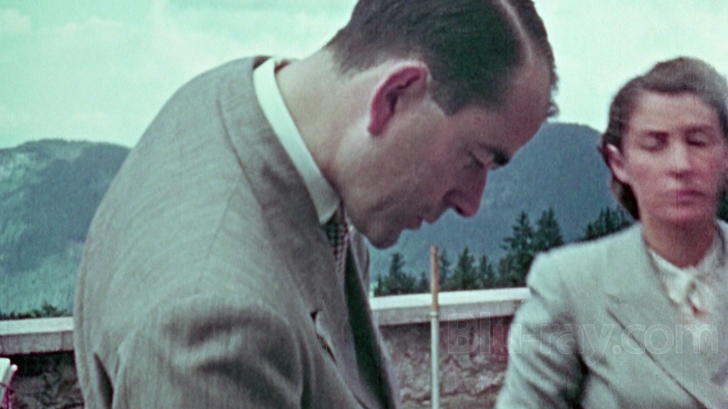The World at War Blu-ray Movie
HomeThe World at War Blu-ray Movie 
A+E Networks | 1973 | 1352 min | Unrated | Nov 16, 2010Movie rating
8.9 | / 10 |
Blu-ray rating
| Users | 3.9 | |
| Reviewer | 4.5 | |
| Overall | 3.9 |
Overview
The World at War (1973)
A multi-volumed documentary mini-series, "The World at War" covers the entire history of World War II from the causes of the 1920s to the aftermath of the Cold War in the 1950s. Emphasis is also placed on several inside story episodes, where events are covered which occurred inside Germany and Japan such as resistance to Hitler, life in general under a dictatorial regime, and particular emphasis is focused on the Jewish Holocaust.
Starring: Anthony Eden (I), Albert Speer, Louis Mountbatten, Wynford Vaughan-Thomas, J.B. PriestleyNarrator: Laurence Olivier
Director: Ted Childs, Michael Darlow, Martin Smith (I), Hugh Raggett, John Pett
| War | Uncertain |
| History | Uncertain |
| Documentary | Uncertain |
Specifications
Video
Video codec: MPEG-4 AVC
Video resolution: 1080p
Aspect ratio: 1.78:1
Original aspect ratio: 1.33:1
Audio
English: DTS-HD Master Audio 5.1
English: LPCM 2.0
Subtitles
English SDH
Discs
50GB Blu-ray Disc
Nine-disc set (9 BDs)
Playback
Region A (locked)
Review
Rating summary
| Movie | 5.0 | |
| Video | 4.0 | |
| Audio | 3.5 | |
| Extras | 4.0 | |
| Overall | 4.5 |
The World at War Blu-ray Movie Review
The gold standard of World War II documentaries comes to Blu-ray in one of the most costly upgrades ever afforded a television series. But it's in 16:9.
Reviewed by Jeffrey Kauffman November 2, 2010The late 1960s to early 1970s may have been the perfectly propitious time period to undertake a mammoth documentary recounting the history of World War II. Enough time had passed that a certain level of objectivity had crept into historical analysis, however slowly at first, but the events were still recent enough that many participants (and victims) of the epochal conflict were still around to reminisce about it. Producer Jeremy Isaacs had been impressed by The Great War, a previous British extravaganza devoted to World War I, and he ultimately became Executive Producer of The World at War, Thames Television’s brilliant 26 part exegesis of the causes, conflicts and personal stories of the 20th century’s most defining few years. So daunting was this task that it actually took several years of research, compilation, and interviewing before the final product was finally ready for broadcast in 1973. Narrated by Laurence Olivier, and containing an iconic theme by Carl Davis (eerily redolent of Prokofiev’s wartime Symphony No. 5), The World at War quickly became the authoritative effort on the conflict. Filled to the brim with haunting first person stories by both combatants and civilians, and with an interesting, not always strictly chronological, take on the epic battle, the series had both a grand scope and an intimate emphasis that made it unforgettable to several generations of viewers who saw it either on its original broadcast run in England, or as it was disseminated across the globe in the ensuing years. The World at War has also had a long history on home video, but as befits such an impressive, and historic on its own terms, release, this new Blu-ray ups the ante rather considerably about what a media company is willing to do to both upgrade a release for high definition as well as to make the product salable in larger, broadcast licensing, terms.

Full screen. Widescreen. 16:9. 4:3. Anamorphic. Do you remember a time when the public at large couldn’t care less about any of these terms? It really wasn’t so long ago. But we home video elitists knew from the earliest days of VHS that we weren’t getting the “whole picture,” at least with regard to post-Robe fare. Many of you home video collectors may have suffered the slings and arrows of spousal outrage as you have repeatedly bought the same title in subsequent releases. My own wife has had a mantra of complaint that “first it was VHS, then it was widescreen VHS, then it was DVD, then it was widescreen DVD, then it was anamorphically enhanced widescreen DVD, and now it’s Blu-ray.” The cynic in me wants to answer, “So, what’s your point?”, but of course the desire to stay married has so far won out, and discretion is the better part of marital valor. But the slow slog toward original aspect ratios has really been one of consumer education. It’s virtually a default now that any major release, whether Academy ratio or 2.39:1, will see the home video light of day in its proper aspect ratio. But Fremantle Media, the owners of The World at War, decided, evidently after much internal debate, to reframe the release of this iconic series in 16:9 as part of its Blu-ray release. Why? Economics, mostly. Quite simply, Fremantle can’t recoup the enormous costs of this expansive restoration and upgrade simply through sales of Blu-rays alone. They must relicense the series to television networks again, and the market now demands a 1.78:1 aspect ratio for high definition marketability. It’s of course ironic in the historic scheme of things, as OAR enthusiasts use to scream about 16:9 (or wider) aspect ratios being trimmed down to 1.33:1. Now quite the opposite has occurred, obviously to some consumers’ chagrin (if not outright outrage).
I’ll mostly defer more commentary about this decision to the video section below, but I would like to make a quick response to consumers who are upset by decisions like this and, to utilize another title I recently reviewed, the decision not to include lossless audio on Grindhouse. We’ve become rather spoiled home video consumers, and sometimes that spoilage makes us more than a bit petulant. I’m old enough to remember when if a classic film didn’t get broadcast on Saturday Night at the Movies, you didn’t get to see it. You similarly had two chances to catch most episodic television, its first broadcast and its one and only rerun. Of course times are different now, and for the most part much better, but temper tantrums are not ultimately going to make any difference to media conglomerates who make these decisions on largely economic grounds. In some cases, they’re indefensible. I would argue in the case of The World at War, that we’ve gotten a rather sizable tradeoff in terms of image upgrade and the care that was taken in the reframing that should at least partially offset purists’ (and I’m one of them) hard feelings.
Now on to the series itself. The 26 episodes of The World at War run the gamut from focusing on specific battles and campaigns to more personal stories of those caught up in the tumult. That was part and parcel of Jeremy Isaacs’ design for the series. He wanted The World at War to play like an episodic drama, where the ending of each episode made the audience eager to return the next week to see what was going to happen. And that sense of drama is infused throughout virtually every outing of this magnificent series. Part of what makes this such exceptionally visceral fare is the ubiquitous interview segments, which feature a host of well known people associated with various campaigns, as well as aides to former Nazi higher-ups, and a plethora of civilians who were caught up in various tragic circumstances. Some of these people are only in their late 30s or early 40s in 1973, and their memories of surviving the war as children are haunting, both to them and the viewer.
The other major element of The World at War which makes it so remarkable is the truly stunning amoung of archival footage, a surprising amount of it in color (all of which has been color corrected for this release, with sometimes amazing results). Everything from the early days of Hitler to iconic moments like the bombing of Pearl Harbor are caught in a vast array of “you are there” newsreels, as well as some really rare and often disturbing footage, such as the American newsman talking to a German and reporting that America has come to understand that the “rumors” of Nazi atrocities are unbelievable and that Hitler’s government is the finest in the world.
But the series really excels at giving a wealth of context for the frankly insane behavior of several of the major nations involved in the conflict, and not just on the Axis side. British appeasement and American isolationism played into the tragedy as surely as did Hitler’s megalomania and racial idiocy, and The World at War provides an at times startlingly, and depressingly, clear view of the unfortunate concatenation of events which ultimately led to the Holocaust and worldwide conflict. Laurence Olivier’s redolent voice provides perfect gravitas for the series, one which never shirks from the horrors visited on mankind, but which also doesn’t glorify or sensationalize anything. In fact one of the reasons this series has been so universally acclaimed is its calm, objective demeanor, one that doesn’t vilify the “enemies” unnecessarily while at the same time refusing to act as apologist for any individual’s, or indeed nation’s, stupidity.
The main 26 part series includes:
A New Germany (1933–1939)
Distant War (September 1939 – May 1940)
France Falls (May – June 1940)
Alone (May 1940 – May 1941)
Barbarossa (June – December 1941)
Banzai!: Japan (1931–1942)
On Our Way: U.S.A. (1939–1942)
The Desert: North Africa (1940–1943)
Stalingrad (June 1942 – February 1943)
Wolf Pack: U-Boats in the Atlantic (1939–1943)
Red Star: The Soviet Union (1941–1943)
Whirlwind: Bombing Germany (September 1939 – April 1944)
Tough Old Gut: Italy (1943–1944)
It's A Lovely Day Tomorrow: Burma (1942–1944)
Home Fires: Britain (1940–1944)
Inside the Reich: Germany (1940-1944)
Morning: (June – August 1944)
Occupation: Holland (1940–1944)
Pincers: (August 1944 – March 1945)
Genocide (1941–1945)
Nemesis: Germany (February – May 1945)
Japan (1941–1945)
Pacific (February 1942 – July 1945)
The Bomb (February – September 1945)
Reckoning (1945. . .And After)
Remember
The World at War Blu-ray Movie, Video Quality 

If you are one of the people who are inconsolable about Fremantle's decision to reframe this release in 16:9, you should probably stop reading now, as
nothing I can say will change your mind about the worthiness of this release. As I mention in some detail above, I feel your pain, I really do. I have
always argued for original aspect ratios on home video releases, especially when a lot of early days panning and scanning was so clumsily handled.
But for those of you who are keeping an open mind, let's move on. The World at War is simply a marvel, a benchstone, of restoration,
delivered via an AVC codec in 1080p and, yes. 1.78:1. Let's get the framing issues out of the way first. Would it have been better to have had this
series in 1.33:1? Probably. But business being what it is, and Fremantle's need to recoup their very substantial restoration costs by relicensing this
series for broadcast made the 16:9 decision inevitable. What is striking about this reframing is how carefully it was done, at least for the most part.
As the restoration featurette shows quite clearly, this was not an automated situation where the original 1.33:1 image was simply blown up to
become 1.78:1. Actual people, not machines, supervised this process, often frame by frame, making sure the salient information was kept in
the image. For about 95% of the time, this effort is largely commendable. Unfortunately, the contemporary interview segments do look
rather silly, with up to one quarter of any given individual's forehead and/or chin lopped off the image. In perhaps a less important issue, the opening
Thames TV logo now cuts the top of the spire off of St. Paul's Cathedral. But otherwise, the framing has been handled spectacularly
smartly.
Now on to the image itself. This restoration is quite simply a revelation, especially for those of us who grew up with the series or have owned it in its
previous home video incarnations. Again, this is state of the art restoration, using in fact a new software that is not even commercially available yet.
The World at War was its maiden voyage, so to speak, and the results are simply stunning. The increase in sharpness and detail is often
breathtaking, and the painstaking removal of millions of scratches, blemishes and surface dirt reveals a whole new wealth of fine detail. Has DNR
been applied? Yes, but not in the way it typically is. Grain structure is still largely intact, especially in the smaller millimeter formats. And in fact
where too much restoration would have harmed the integrity of the image, as in some of the color film of Hitler at Berchtesgaden, next to
nothing has been done.
This was obviously a labor of love for Fremantle and the associated high-tech wizards who helped with the restoration and hi-def transfer. Fremantle
went back to its archives, often to 35mm negatives, to source from the best available elements used for this transfer, and it shows in virtually every
frame. The older black and white footage now bristles with brilliant contrast and excellently inky black levels, and the color footage has been timed by
telecine experts who have often worked wonders, especially with the older Technicolor segments. All of this said, there are noticeable differences in
various source elements. The 35mm footage looks substantially better than the 16mm, as is to be expected, and even some of the 35mm (as well as
the 16mm) sports some wear and tear that even digital restoration can't overcome.
People coming to this release without having seen The World at War in either its standard def broadcast version or any of the previous home
video releases may wonder what all the brouhaha, both pro and con, is about. We're dealing with an incredible amount of archival footage here, and
even a painstaking digital restoration can only go so far in bringing the image quality up to current day standards. But for those who have
seen this series in previous iterations, if you can get past the reframing issue, you are most likely going to be amazed at the upgrade in image quality
here.
The World at War Blu-ray Movie, Audio Quality 

The results aren't quite so mind (or ear) boggling as the video quality, but the DTS-HD Master Audio 5.1 repurposed track sounds surprisingly spry for its age, even if the surround channels aren't exactly constantly in motion. The immersive qualities of this multi-channel re-do are obviously most impressive in the battle footage, where the roar of plane engines clearly pans from side to side and bombs explode from front to rear. Dialogue and music remain pretty resolutely anchored in the front channels. Olivier's voice sounds just slightly chorused in the 5.1 mix, and some may prefer the lossless LPCM 2.0 mix for that reason. Davis' haunting score sounds magnificent, and the LFE of the new lossless tracks is very robust. Archival source material still sounds crackly, poppy and scratchy, with compressed frequencies and an overall boxy sound, but that somehow only seems to make it more "real" in a historical perspective. The main interview segments and Olivier's voiceover are clear as a bell and very well mixed into the overall soundfield.
The World at War Blu-ray Movie, Special Features and Extras 

All of the extras from the previously released DVD boxed set have been ported over, upgraded to HD and, yes, converted to 16:9. One new documentary on the restoration itself is included. The supplements are:
- Each episode (including the extras themselves) offer a sort of bookmarking feature split into Photo Galleries, Historical Footage, Songs, Speeches, Quotes and Maps. While these are potentially useful in theory, what they actually do is simply start the episode from that bookmarked point and play it forward. To navigate from section to section you need to go back to the Extras menu.
- Biographies (text) of all the "major players" and many interview subjects are included.
- Episode Summaries (text) of all the 26 main episodes and the supplemental features are included.
- A Brief History of 'The World at War' (text) offers a short summary of the series' background.
- Hitler's Germany is a two part affair that really covers much of the same ground as other episodes. The People's Community 1933- 1939 (HD; 1:18:11) and Total War: 1939-1945 (HD; 1:19:38) chart the course of post-World War I trauma paving the way for Hitler's rise and the tragic consequences that entailed.
- The Two Deaths of Adolf Hitler (HD; 49:02) discusses the then (mid 1970s) hotly debated topic of how Hitler died.
- Secretary to Hitler (HD; 24:32) is a fascinating, in depth conversation with Trudl Junge, Hitler's secretary.
- Warrior (HD; 52:52) is a riveting first hand account by the "grunts" who did the actual fighting, describing what killing another human did to them on a personal level.
- From War to Peace (HD; 23:48) is a somewhat dated look at post-war Germany and where the world stood in the mid 1970s.
- The Final Solution is a heartbreaking and extremely disturbing two part look at Auschwitz. Part One (HD; 1:40:36) describes Hitler's racial policies and how they led to the Holocaust. The opening segments might lead you to think you're listening to Holocaust deniers but, no, these are people who lived through it—as children—and who can't quite believe it ever happened. Part Two (HD; 1:34:24) gets into the nuts and bolts of the "death factories."
- Experiences of War (HD; 1:01:19) offers extended interview segments which were edited for the series itself.
- The Making of the Series (HD; 50:17) details how The World at War came to be.
- Making the Series: A 30th Anniversary Retrospective (HD; 2:08:26) is an exhaustive look back on this monumental undertaking.
- Restoring 'The World at War' (HD; 31:04) is a fascinating look at the incredible array of high tech wizardry which was used to upgrade
this release. Anyone who may think any of the decisions with regard to this release, and its reframing in particular, were made cavalierly owes it to
themselves to watch this really excellent piece. It makes it quite clear that everyone wanted this Blu-ray to be an exceptional product, and no
decision was taken lightly.
The World at War Blu-ray Movie, Overall Score and Recommendation


I came rather late in my parents' lives, and have in fact joked for many years that I was my parents' mid-life crisis. I therefore grew up with a father who had himself been part of the Greatest Generation and who was a pretty famous Army man (a Major General by the end of his career) in his own right. That made me perhaps more attuned to the history and impact of World War II than a lot of people my age, but as we get further and further away from the mid-20th century, there are even fewer people around with even a tangential relationship to World War II. That's why The World at War is such a timeless and important documentary. Never before had so many first hand accounts been memorialized, documenting the conflict from every side. Never before had such an exhaustive approach to the war been attempted, at least for television. This new Blu-ray is no doubt going to be one of the more controversial catalog releases of 2010 due to Fremantle's decision to reframe it for 16:9 screens. I typically am a stalwart believer that original aspect ratios should be honored, and I don't feel differently after having watched this new version. However, I'm not about to throw the baby out with the bath water, especially when it's completely obvious that this Blu-ray version has been accorded incredible care. A 1.33:1 version would have been preferable, yes, but this package, though pricey, is a significant upgrade from the SD-DVD version and I can confidently give it my highest recommendation.
Similar titles
Similar titles you might also like

The World Wars
2014

WWII in HD
World War II in HD
2009

Apocalypse: World War II
2010

They Shall Not Grow Old
2018

The Vietnam War
2017

The War
2007

Emperor
2012

Restrepo
2010

Victory at Sea
Deluxe Edition
1952-1953

Land of Mine
Under Sandet
2015

The Longest Day
1962

Journey's End
2017

The Killing Fields
1984

Shoah
1985

Battle of Britain
1969

Beneath Hill 60
2010

Patton
1970

Fat Man and Little Boy
1989

A Bridge Too Far
1977

Generation War
Unsere Mütter, unsere Väter
2013
